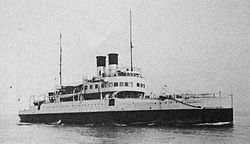Mecklenburg (ship, 1903)
|
Ship Mecklenburg after the renovation in 1926
|
||||||||||||||||||||
|
||||||||||||||||||||
|
||||||||||||||||||||
|
||||||||||||||||||||
|
||||||||||||||||||||
The Mecklenburg was a German steam-powered rail ferry that ran from 1903 to 1945 on the Warnemünde – Gedser line as the first international rail ferry. Confiscated by the Allies in 1945, it was used as a Polish freight train ferry between Swinoujscie and Ystad from 1950 to 1953 .
history
On Dec. 9, 1900 agreed Denmark and Mecklenburg setting up a Trajektes between Warnemünde and Gedser and the construction of ferries and traders. The Grand Ducal Mecklenburg General Railway Directorate of the Friedrich-Franz-Eisenbahn commissioned the screw ferry Mecklenburg and the side wheel ferry Friedrich Franz IV from the F. Schichau shipyard in Elbing . The cost was about 900,000 marks . The launch of the Mecklenburg took place on April 4, 1903, the commissioning at the opening ceremonies of the Trajektroute on September 30, 1903. The route was the first international railway ferry line.
During the First World War , the line was initially completely discontinued. The two German ferries were mainly used to transport troops and equipment along the Baltic coast. Only the Danish ferries, marked as neutral ships, kept up little traffic. After the end of the war, the German ferries were mainly used to transport Allied prisoners of war who returned to their homeland via Denmark and Sweden.
As a result of the merger of the Länderbahnen, Mecklenburg became the property of the Deutsche Reichsbahn in 1920 . In 1924, the Mecklenburg received a second chimney during renovation work in order to get more space on the track deck. Another modernization took place in 1935/1936. After the introduction of the new German Schwerin ferry in 1926, the Mecklenburg mainly transported goods and maintained the limited winter service. In the icy winter 1928/1929 it was in the Baltic Sea by ice and had, like many other ships also, of aircraft of the Pilot School in New York City with parachutes proviantiert be. It was not until March 12 that two Soviet icebreakers, Jermak and Truvor , chartered by the Reich Ministry of Transport , liberated the ship. Like Schwerin , who was also stuck in the ice , it was damaged and both ferries had to go to the shipyard .
The German Wehrmacht used the Mecklenburg on the morning of April 9, 1940 to attack Denmark ( Operation Weser Exercise -South). German troops were the first to disembark from the ferry in Gedser at 4:15 a.m. To hide their presence for as long as possible, the soldiers were hidden under large tarpaulins on the deck of the ferry. The same morning the Schwerin was used. They brought more troops and military equipment to Gedser. The main task of the troops that morning was to take the Storstrømsbrücke . By evening the German Wehrmacht had occupied the whole of Denmark almost without a fight.
During the Second World War , the Mecklenburg continued on its main line and mainly transported soldiers, Wehrmacht goods and Danish products that were imported to Germany. With the occupation of Warnemünde by the Red Army on May 1, 1945, ferry traffic was stopped.
The Mecklenburg was assigned to the Soviet Union as a reparation payment . In the autumn of 1945, the ship was used for the repatriation of Poland and sailed the route Lübeck - Gdansk . The Soviet Union finally gave the ship to Poland . Under the Polish flag , the former Mecklenburg, as Kopernik, last served the Swinoujscie - Ystad railway ferry , on which it mainly transported freight wagons with coal. From the end of 1953, the former Mecklenburg was used as a living and workshop ship in Danzig, where it was finally demolished in 1958.
Technical specifications
The length of the ship was 86 meters, the width 14 meters, the width over rub rails 17.7 meters. With a side height of 7 meters, the draft was 4.12 meters. The measurement was given as 1210 GRT / 532 NRT, with a displacement of 2100 tons. The steam engine had an output of 1840 kW. The ship reached a speed of 13.4 knots. 15 freight wagons could be transported on two tracks with a total length of 125 meters.
literature
- Gert Uwe Detlefsen: Inland and ocean-going vessels as well as the ferries of the German railways , Flechsig, Würzburg [o. J.], ISBN 3-88189-509-4 , p. 131
- Alfred Dudszus, Alfred Köpcke: The big book of ship types. Steam ships, motor ships, marine technology from the beginnings of machine-driven ships to the present day. transpress Pietsch, Berlin Stuttgart 1990, ISBN 3-344-00374-7 , pp. 202-203.
- Jan Piwowoński: Flota spod Biało-Czerwonej , Nasza Księgarnia, Warszawa 1989, ISBN 83-10-08902-3 , p. 206ff.
Web links
Individual evidence
- ^ Information from the weather station about the 1929 ice.
- ↑ 3rd Combat Group of the 198th Infantry Division under Kdr. IR 305, Colonel Albert Buck (1895-1942), with III./IR 305, 14./IR 305, 3./MG-Bataillon 13, Radfahr-Squadron 235, 1st / pioneer bag 235, 2 medium-sized radio stations, communications department 235, staff to operate the ferries. They were to advance through the island of Falster and across the strait at Vordingborg to gain a bridgehead north of Vordingborg for the following parts of the division. A company of paratroopers was assigned to jump off at Masnedö at 6:15 a.m. and secure the bridges for the approaching combat group.
- ↑ Information on Ystad based on the Polish Wikipedia; but probably Swinoujscie- Trelleborg


